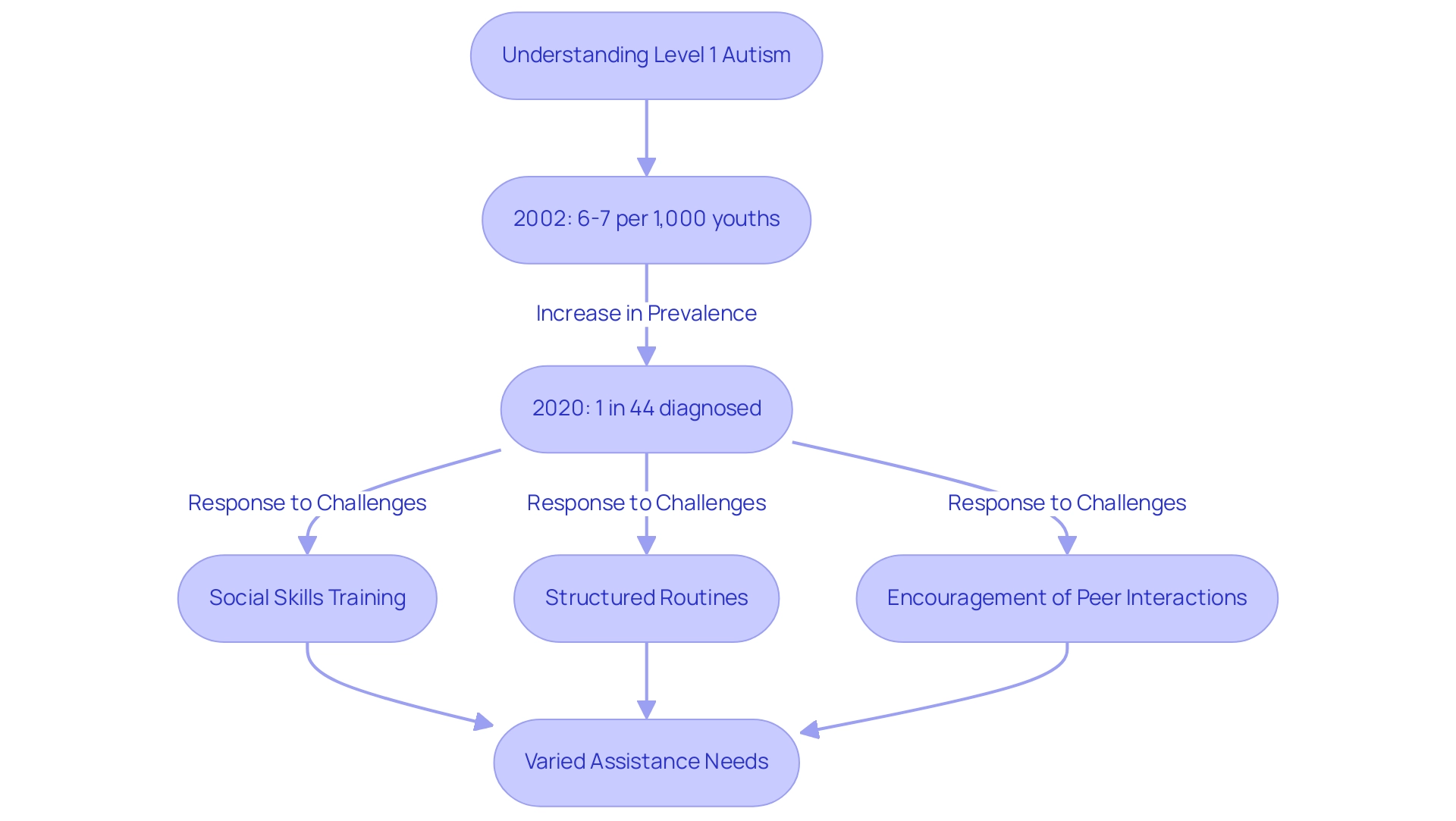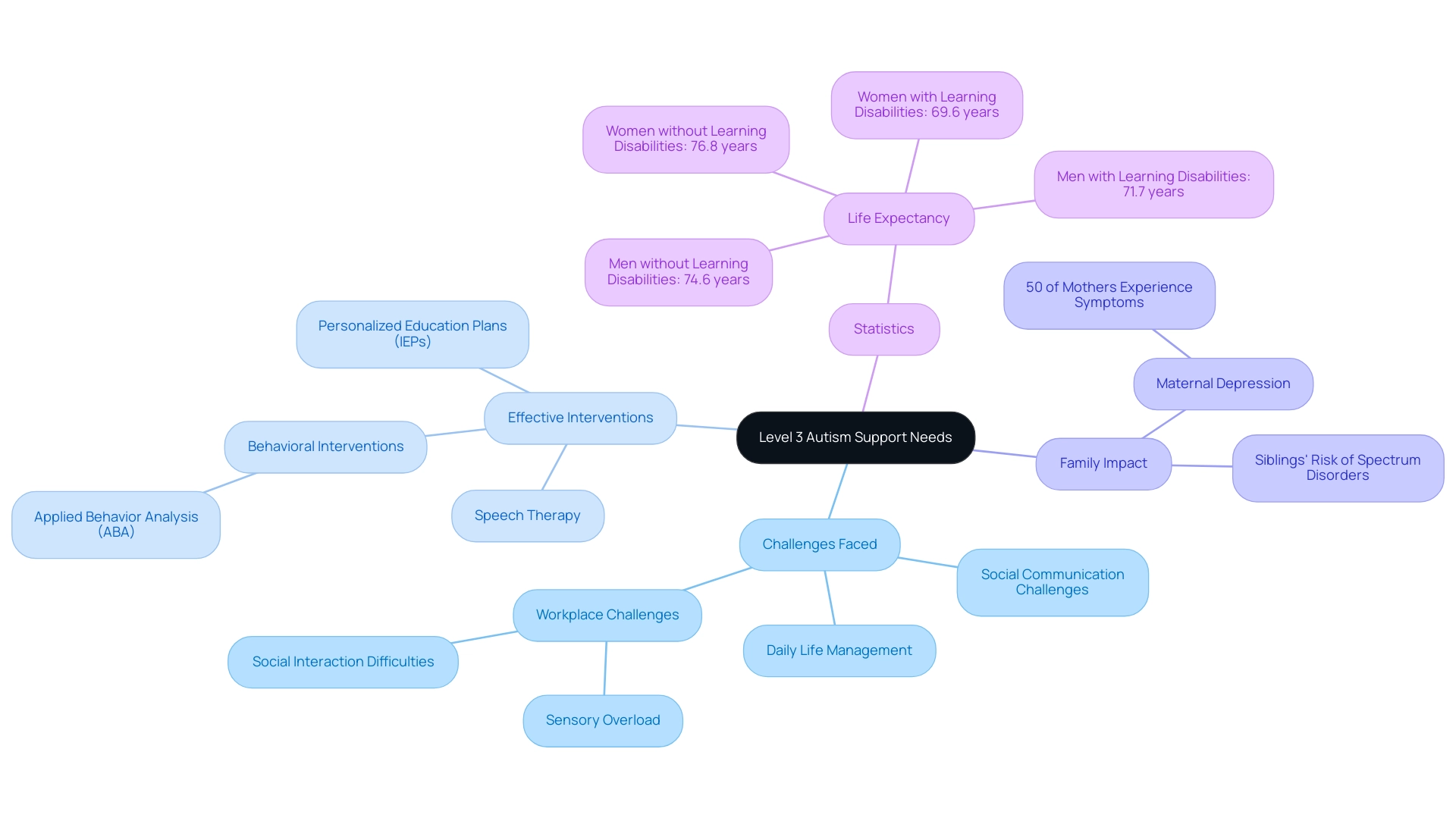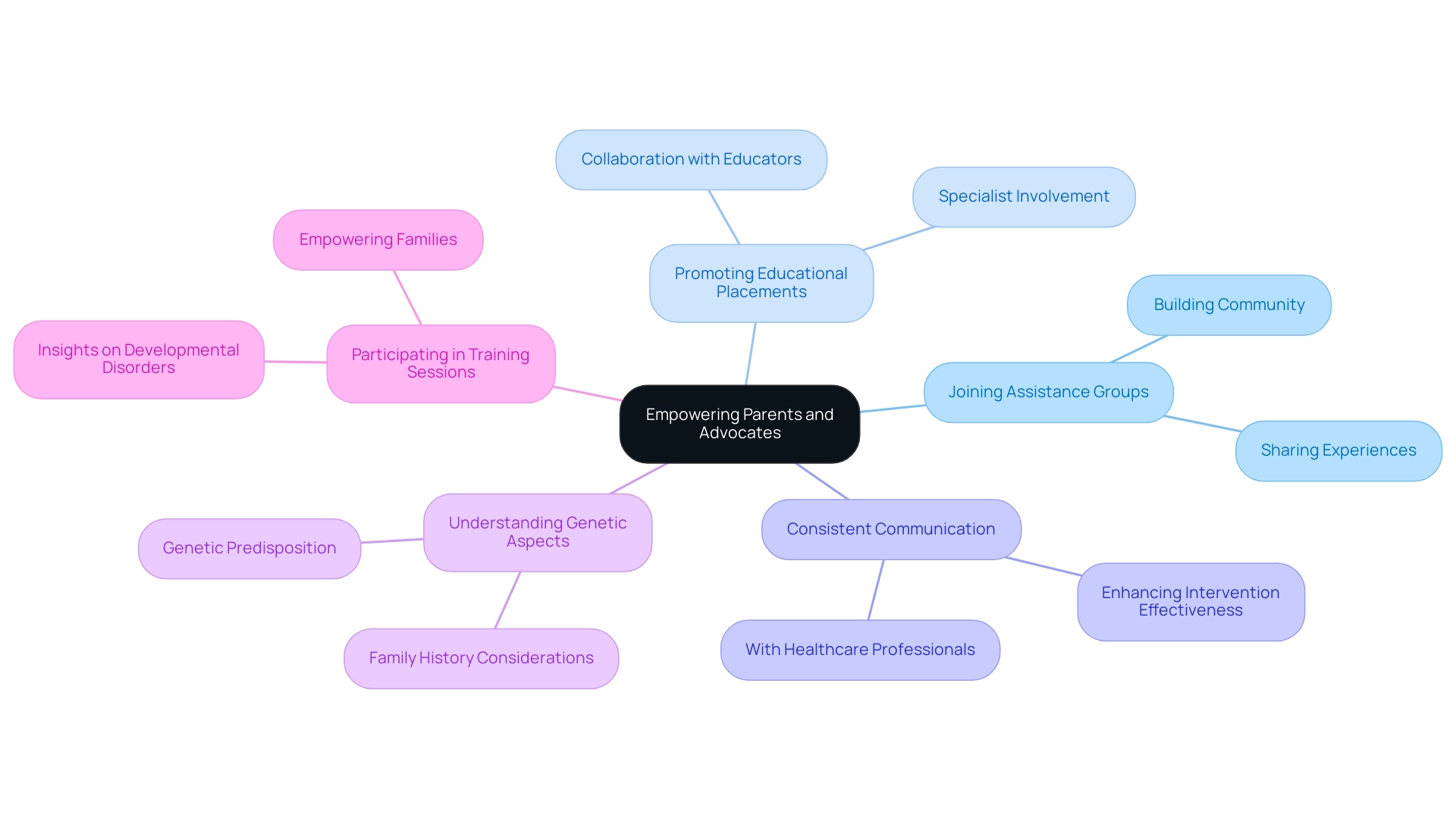Overview
The article focuses on understanding the different levels of Autism Spectrum Disorder (ASD) and their implications for support and intervention strategies for individuals and their families. It outlines three levels of autism—Level 1, Level 2, and Level 3—each defined by the degree of assistance required, and emphasizes the importance of early intervention and tailored support strategies to improve outcomes for individuals on the spectrum, as evidenced by research highlighting the diverse needs and challenges faced by these individuals.
Introduction
In a world that increasingly recognizes the diversity of human experiences, Autism Spectrum Disorder (ASD) stands out as a complex neurodevelopmental condition that affects millions. With its broad spectrum of symptoms and varying degrees of support needs, understanding ASD is crucial for fostering awareness and inclusion.
Recent statistics reveal alarming trends in prevalence and diagnosis, particularly highlighting disparities among different demographics. This article delves into the intricacies of autism, exploring its levels, characteristics, and the vital importance of early intervention.
By shedding light on the unique challenges faced by individuals with ASD and their families, it aims to empower parents, advocates, and society at large to create a more inclusive environment for everyone on the spectrum.
What is Autism Spectrum Disorder (ASD)?
Autism Spectrum Disorder (ASD) represents a multifaceted neurodevelopmental condition characterized by difficulties in social communication, repetitive behaviors, and restricted interests. The term 'spectrum' effectively captures the broad range of symptoms and severity that may manifest, reflecting the various levels of autism and ensuring that each individual with autism presents uniquely. Recent research indicates that the overall prevalence of ASD across various sites is approximately 27.6 per 1,000 youths, with a notable discrepancy in gender prevalence:
- 43.0 for males
- 3.8 for females
yielding a male-to-female ratio of 11.4.
Alarmingly, 74.7% of individuals who met the ASD case definition had a documented diagnostic statement of ASD, underscoring the importance of accurate and timely diagnosis. This disparity in diagnosis and prevalence highlights the necessity for equitable service allocation for individuals diagnosed with levels of autism. Prompt identification of the indicators of developmental disorders is essential, as it enables timely intervention and customized assistance, ultimately affecting results for young individuals.
As Judy Singer aptly noted, the symbol she created in the 1990s promotes the inclusion of everyone on the autism spectrum, reinforcing the need for awareness and appropriate resources. Furthermore, the presence of co-occurring conditions, such as:
- epilepsy affecting up to 30% of autistic children
- gastrointestinal disorders
- sleep problems
- ADHD
- anxiety
highlights the complexity of managing ASD, making early intervention all the more vital.
An Overview of the Levels of Autism Spectrum Disorder
Autism Spectrum Disorder (ASD) is classified into three unique levels, each outlining the extent of assistance needed by persons.
- Level 1, often referred to as needing help, is marked by significant challenges in social communication, but people can usually operate with some assistance.
- Level 2 requires considerable assistance, as people display more pronounced challenges in social interactions and may struggle with coping in various situations.
- Level 3, classified as requiring very substantial support, denotes severe impairments in communication and behavior, significantly impacting daily functioning.
Comprehending these classifications is essential for parents and advocates, as they assist in guiding the suitable interventions and resources needed for each person. Significantly, research suggests a genetic factor related to the condition, showing that people with affected siblings encounter a greater likelihood of obtaining an ASD diagnosis.
This genetic correlation highlights the significance of early identification and customized assistance strategies. Moreover, the distribution of levels of autism among diagnosed individuals underscores the need for specialized services to effectively meet diverse developmental and behavioral needs. It is also important to consider the financial implications of assistance, as therapeutic behavioral services can cost around $175.44.
Additionally, a recent case study titled 'A New Pattern in Racial and Ethnic Differences Emerges in ASD Identification' discusses emerging patterns in the identification of ASD among 8-year-old children, focusing on racial and ethnic differences, which could provide valuable insights for advocates. Moreover, as Judy Singer, the originator of the emblem for inclusion concerning developmental differences, mentioned, 'Inclusion is vital for all individuals on the spectrum,' highlighting the significance of advocacy and assistance in nurturing an inclusive setting.
Understanding Level 1 Autism: Characteristics and Support Needs
Levels of autism, specifically Level 1 Autism, often referred to as requiring support, are characterized by notable challenges in social communication. Individuals with this level of the condition can often speak in full sentences and engage in interactions; however, they typically struggle with social cues and maintaining conversations. The prevalence of the condition has experienced a significant increase over the years.
For instance, by 2002, the prevalence was around 6-7 per 1,000 youths, which contrasts sharply with the CDC's 2020 estimate of approximately 1 in 44 individuals diagnosed with autism spectrum disorder. This alarming increase underscores the urgency for effective support strategies. The CDC's estimates are based on 8-year-old children across 11 monitoring sites in the Autism and Developmental Disabilities Monitoring (ADDM) Network, adding credibility to these statistics.
To effectively assist people with levels of autism, various strategies have been developed, including:
- Social skills training
- Structured routines
- Encouragement of peer interactions
These interventions aim to improve socialization and help individuals navigate social situations more comfortably. Real-world examples of social skills training demonstrate how structured environments can foster communication skills and confidence.
Furthermore, a study indicates that mothers of autistic children often seek professional assistance and educational resources, while fathers tend to emphasize the importance of social development and self-care. This emphasizes the varied assistance needs within families and the necessity for tailored approaches to care. Creating inclusive environments is crucial, as Judy Singer noted; the symbol she created in the 1990s aims to promote the inclusion of everyone on the autism spectrum.
Comprehending and addressing these varied traits and assistance needs are essential as we strive to provide effective and compassionate care for those with levels of autism, including Level 1 Autism. Autism is a complex neurodevelopmental disorder, and the influence of parental genetics plays a significant role in its manifestation, further emphasizing the need for comprehensive understanding and assistance.

Exploring Level 2 Autism: Needs for Substantial Support
Levels of autism, particularly Level 2, are marked by considerable difficulties in social communication and behavior, requiring substantial assistance for individuals to manage social interactions and daily living activities. Data indicates that among various demographics, the prevalence of Autism Spectrum Disorder (ASD) is notably higher in Hispanic communities, being 1.8 times greater than in non-Hispanic White children, and 1.6 times greater among non-Hispanic Black children. This emphasizes the varied assistance needs within the autism community.
Individuals with levels of autism, particularly Level 2, often face limited verbal communication capabilities and difficulty adapting to changes in routine, which can exacerbate anxiety and hinder engagement. To tackle these challenges, effective assistance strategies have emerged, including:
- Structured environments that provide predictability
- The use of visual aids to enhance understanding
- The implementation of consistent routines that foster a sense of security
Recent advancements in assistance strategies emphasize the importance of these approaches, as research has shown that such methods significantly improve the quality of life for individuals with levels of autism, including Level 2 Autism.
For example, visual aids such as schedules and social stories can be invaluable tools for enhancing communication and facilitating smoother transitions in their daily activities. Additionally, the CDC is committed to providing essential data on ASD and developing resources for early identification, which is crucial for supporting families. Views from parents unveil the significance of:
- Professional traits
- Respite care
- Assistance groups
- Counseling
As noted by mothers, while fathers stress the necessity for social development aid and self-care.
Moreover, the number of peer-reviewed articles on autism has risen considerably, demonstrating the increasing awareness and research in the field, which highlights the significance of effective assistance strategies. Ultimately, the goal is to create an environment that not only accommodates their unique challenges but also promotes their engagement and development.
Navigating Level 3 Autism: Understanding Very Substantial Support Needs
Levels of autism, particularly Level 3, are marked by profound challenges in social communication and significant difficulties in managing daily life. Individuals at this level often struggle to establish and maintain relationships, necessitating very substantial assistance. The need for support is emphasized by research indicating that around 50% of mothers of autistic individuals experience symptoms of depression, highlighting the broader impact on families.
Effective assistance strategies may include:
- Intensive behavioral interventions, which have been shown to yield positive outcomes;
- A study published in the Journal of Autism and Developmental Disorders noted that Applied Behavior Analysis (ABA) therapy significantly reduces stereotypic behaviors in autistic children.
- Speech therapy and personalized education plans (IEPs) customized to each person's unique needs are vital elements of a comprehensive support framework.
Current interventions are increasingly focusing on these tailored approaches, as they address the specific requirements of people with levels of autism, particularly Level 3.
For instance, a 2023 study on the life expectancy of autistic people revealed that those with severe symptoms might face more pronounced challenges, with autistic men without learning disabilities living an average of 74.6 years and women without learning disabilities averaging 76.8 years. In contrast, those with learning disabilities face shorter life expectancies, averaging 71.7 years for men and 69.6 years for women. Additionally, autistic people often encounter challenges in the workplace, such as sensory overload and difficulties with social interaction, which can further complicate their daily lives.
Comprehending these dynamics, including the heightened risk for siblings of individuals with autistic traits to develop related spectrum disorders, is vital for promoting effective resources and interventions that address the unique support requirements of individuals at various levels of autism, especially those with Level 3 conditions.

The Importance of Early Intervention and Support Strategies
Studies consistently show that early intervention is crucial in improving communication skills, social abilities, and the overall quality of life for individuals on the spectrum. Families are strongly encouraged to pursue assessments and interventions as soon as they observe signs of autism, which can lead to more effective outcomes. A recent study confirmed that ASD prevalence was 1.8 times as high among Hispanic children and 1.6 times as high among non-Hispanic Black children compared to non-Hispanic White children, highlighting the need for early intervention across diverse populations.
Support strategies such as:
- Applied Behavior Analysis (ABA) therapy
- Occupational therapy
- Speech therapy
are tailored to meet individual needs and foster developmental growth. Additionally, a case study indicates that having a sibling with autism increases the likelihood of ASD, underscoring the necessity for families with a history of autism to act promptly. Given that only 25% of autistic adults are fully employed, the urgency of addressing these concerns is paramount.
Parents often express worries about their child's future and the challenges of future planning, which further emphasizes the importance of early intervention to empower their child's development and ensure they receive the best possible support from the outset.
Debunking Myths: Understanding the Spectrum of Autism Needs
Autism Spectrum Disorder (ASD) is often misunderstood, with persistent myths suggesting that all individuals on the spectrum have the same levels of autism or exhibit uniform traits. In truth, this condition encompasses a broad range of abilities and challenges, including different levels of autism, reflecting the diversity of human experience. This variation is crucial for fostering empathy and encouraging inclusive practices.
As Judy Singer, a prominent advocate for awareness of the condition, stated, 'Created by Judy Singer in the 1990s, the symbol aims to promote inclusion of everyone on the spectrum.' This emphasizes the significance of acknowledging and accepting the diversity within this condition. Recent discussions emphasize that understanding the levels of autism is vital for dismantling misconceptions and recognizing the unique characteristics of each individual.
For example, while some individuals may require extensive assistance in communication due to different levels of autism, others may thrive in particular domains, highlighting the variety of skills found within the community. Furthermore, the financial consequences of developmental disorders can be considerable, with adaptive behavior services priced around $82.25 and emergency room visits averaging $1,397.22, highlighting the necessity for extensive assistance systems. Moreover, a case study on treatment, intervention, and assistance reveals differing requirements, with mothers focusing on professional qualities and respite, while fathers emphasize social development aid and self-care.
By recognizing these differences and the related expenses, we can better assist those at different levels of autism and champion their requirements, ultimately resulting in a more inclusive society.
Empowering Parents and Advocates: Strategies for Effective Support
Parents and advocates play an indispensable role in supporting individuals with autism, and staying informed about their unique needs is paramount. One key strategy is joining assistance groups, which provide a platform for sharing experiences and resources, ultimately reinforcing the importance of community in advocacy. Studies have demonstrated that youngsters who underwent two years of intensive ABA therapy beginning before age 3 displayed greater improvements in cognitive and language abilities compared to a control group, highlighting the importance of early assistance.
Furthermore, promoting suitable educational placements is essential; parents must collaborate with educators and specialists to guarantee their child receives the best possible assistance. Consistent communication with healthcare professionals also enhances the effectiveness of interventions. As noted by Wiley Online Library, there are several possible reasons why ASD is more commonly diagnosed in boys, highlighting the need for tailored approaches in advocacy.
Furthermore, understanding the genetic aspect of this condition is vital; research indicates that the spectrum disorder tends to run in families, suggesting a genetic predisposition that parents should consider in their advocacy efforts. Establishing a robust support network allows parents and advocates to navigate the complexities of advocacy for individuals with varying levels of autism more effectively. Participating in training sessions about developmental disorders can provide valuable insights that further empower families.
As emphasized by experts, a collective approach enhances the ability to address individual needs and fosters an environment where individuals with autism can thrive.

Conclusion
The exploration of Autism Spectrum Disorder (ASD) reveals the profound complexity and diversity inherent within the condition. From understanding the varying levels of autism—ranging from Level 1, requiring support, to Level 3, necessitating very substantial assistance—each individual presents unique challenges and strengths. The statistics indicating rising prevalence rates, particularly among different demographic groups, underscore the urgency for timely and effective interventions.
Early intervention emerges as a pivotal theme throughout the discussion, illustrating its critical role in enhancing communication abilities and overall quality of life for children on the spectrum. Support strategies such as:
- Applied Behavior Analysis (ABA)
- Tailored educational plans
are essential for fostering development and ensuring that individuals receive the care they need from an early age. Moreover, the emphasis on parental and community involvement highlights the importance of building robust support networks to navigate the complexities of autism advocacy.
Ultimately, fostering a more inclusive society requires a collective effort to dismantle myths surrounding autism and embrace the wide range of abilities present within the community. By empowering parents and advocates, and recognizing the value of early and tailored support, society can take significant strides towards understanding and accommodating the needs of individuals with ASD. The call to action is clear: awareness, advocacy, and action are vital for creating an environment where everyone on the autism spectrum can thrive.
Frequently Asked Questions
What is Autism Spectrum Disorder (ASD)?
Autism Spectrum Disorder (ASD) is a neurodevelopmental condition characterized by difficulties in social communication, repetitive behaviors, and restricted interests. The term 'spectrum' reflects the wide range of symptoms and severity that can manifest in individuals with autism.
What is the prevalence of ASD?
The overall prevalence of ASD is approximately 27.6 per 1,000 youths, with a notable gender discrepancy: 43.0 for males and 3.8 for females, resulting in a male-to-female ratio of 11.4.
Why is accurate diagnosis important for individuals with ASD?
Accurate and timely diagnosis is crucial as 74.7% of individuals who met the ASD case definition had a documented diagnostic statement of ASD. This highlights the need for equitable service allocation and timely intervention, which can significantly impact outcomes for young individuals.
What are the levels of Autism Spectrum Disorder?
ASD is classified into three levels: 1. Level 1: Needing help, with significant challenges in social communication but some ability to operate with assistance. 2. Level 2: Requiring considerable assistance due to more pronounced challenges in social interactions. 3. Level 3: Requiring very substantial support, indicating severe impairments in communication and behavior that significantly affect daily functioning.
What co-occurring conditions are associated with ASD?
Individuals with ASD may experience co-occurring conditions such as epilepsy (affecting up to 30% of autistic children), gastrointestinal disorders, sleep problems, ADHD, and anxiety, which complicate the management of ASD.
How does genetics play a role in ASD?
Research suggests a genetic factor related to ASD, indicating that individuals with affected siblings are at a higher likelihood of obtaining an ASD diagnosis. This emphasizes the importance of early identification and customized assistance strategies.
What are the financial implications of assistance for individuals with ASD?
Therapeutic behavioral services for individuals with ASD can be costly, averaging around $175.44, highlighting the financial considerations involved in obtaining support.
What recent research has emerged regarding racial and ethnic differences in ASD identification?
A recent case study titled 'A New Pattern in Racial and Ethnic Differences Emerges in ASD Identification' discusses emerging patterns in the identification of ASD among 8-year-old children, focusing on racial and ethnic differences, which may provide valuable insights for advocates.
What is the significance of inclusion for individuals with ASD?
Inclusion is vital for all individuals on the spectrum, as emphasized by Judy Singer, the originator of the emblem for inclusion concerning developmental differences. Advocacy and assistance are crucial in fostering an inclusive environment.




